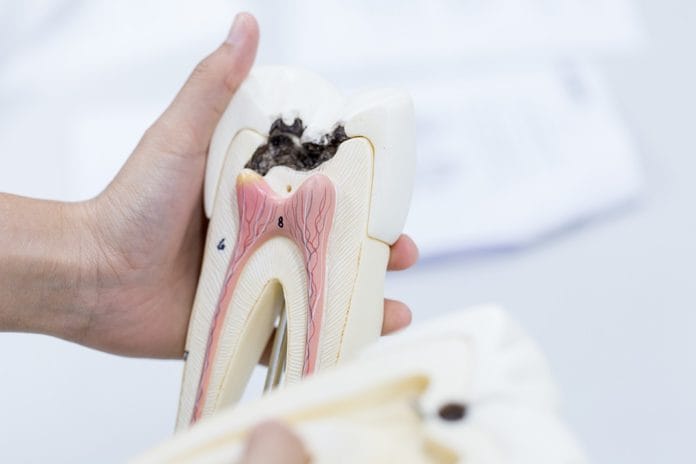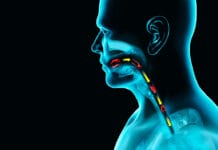Many dental offices, including the one I practice in today, are now mercury-free. Most of our patients are up-to-date with the research that mercury is a neurotoxin and, at certain levels, can cause neurological issues, autoimmune disease, chronic illnesses, and mental disorders. We now have sufficient evidence-based research to acknowledge mercury restorations are not the ideal option they once were. On to more biocompatible materials!
However, what about those patients who have read horror online stories about toxic effects of heavy metals and now want nothing more than to remove their mercury restorations? Many dental offices, including the one I practice in today, do just that. Is this an easy procedure necessary for every patient? Is it safe for every patient? While your patient and dentist may be hasty to go forward with removal, there is critical information we must know when discussing mercury removal with our patients which can help protect their health. This might be a shocker to some of our patients, but the best answer isn’t necessarily to have them removed.
If all of the patient’s amalgam restorations are intact, one would say, don’t wake a sleeping dog!
Unless a tooth with a mercury amalgam cracks, breaks, or decays, it’s best not to remove the restoration and cause unnecessary trouble. The mercury is contained and will be far less detrimental to one’s health if they’re left alone. However, if amalgam restorations are around 20 plus years old, are damaged, or causing gingival inflammation due to irregular margins or overhangs, and/or have recurrent decay underneath, these are obvious reasons for replacement with other materials1. Additionally, the World Health Organization (WHO) states the exposure to mercury vapor can greatly increase beyond the acceptable dose due to habits such as clenching or grinding, chewing gum or hard foods like nuts, and drinking carbonated drinks2. So also ask your patients if they have any of these habits to help determine their risk1.
However, if a patient currently struggles with a host of health issues, such as memory loss, heart palpitations, deficiencies, a heavy viral or toxic load, sensitive nervous system, etc., it’s crucial to consult their physician, as the removal likely triggers and exaggerates their sickness and they may experience a tragic collapse of their health and well-being.
If your patients are candidates for amalgam removal (or simply insist upon it), it is important they do not remove them all at once. Instead, recommend one or two small restorations be removed every month, or every three, or even every six months, depending on your patients’ overall health. We know as a restoration is removed, mercury in the amalgam can vaporize, enter the bloodstream, and weaken the immune system2. Spacing out the removal process of each amalgam allows the immune system to recover from the release of the mercury and helps minimize the impact on one’s health, especially for those who already struggle with neurological symptoms, sensitivities, or illness.
The removal of these restorations, and the subsequent vaporized mercury act as a trigger, and when the immune system is in a weakened state, viral and bacterial infections can easily take root and grow stronger by feeding on the mercury released into the bloodstream3. Many people suffer from neurological symptoms and conditions such as severe anxiety, depression, tingles, numbness, brain fog, memory loss, fibromyalgia, neuropathy, MS, ringing in the ears, vertigo, dizziness, fatigue, and many other mystery symptoms after having their fillings removed all at once4-7. Because of this, a heavy metal detox, before and after removal of mercury fillings, is critical to ensure the immune system is able to fight the potential of a toxic overload— even with only one filling removed1,7.
Whole foods are the best way to detox heavy metals from the body. They work by grabbing onto metals and pulling them out of the body. Here are eight detoxing foods to recommend to your patients8:
Hawaiian Spirulina is an edible, blue-green algae. Take two teaspoons mixed in water, coconut water, or juice, or buy it in tablet form. Chlorella is also great for heavy metal detoxing, though spirulina seeks out mercury specifically.
Barley Grass Juice Extract Powder prepares the mercury for complete absorption by the spirulina, so take these together. Drink as a shot dissolved in hot water, or mix 1-2 teaspoons into coconut water or juice, or add to a green smoothie.
Cilantro clears metals which have been in your system for an extended period of time. Blend one cup in a smoothie or juice, or add to pasta, salads or guacamole.
Wild blueberries are well-known, potent antioxidants which can help reverse any oxidative damage left behind by the heavy metal removal. This is especially important for your brain tissue. It is recommended to eat at least one cup daily when detoxing, so either find wild blueberries in the freezer section or a powder form for easy storage and use. ***I want to stress that while cultivated blueberries are nutritious and delicious, they lack the metal-drawing ability that wild blueberries have.***
Atlantic Dulse goes into deep, hidden places of the digestive tract and gut, seeking out mercury, binding and holding on to it until it leaves the body. It acts as an emergency backup as it even grabs onto other metals along the way, driving them out as well, helping to ensure all the heavy metals that made it as far as the colon leave the body. Eat two tablespoons of flakes daily (I love making my own gomasio and putting that on everything), or an equal amount of strips if it’s in whole-leaf form. Dulse wraps are super yummy snacks.
Celery The mineral salts in the celery juice give extra support to the five heavy metal detox foods by helping to flush metals out of the liver, especially consumed in the morning on an empty stomach.
Apples The pectin in the skins of apples, binds to heavy metals and carries them out of the body to keep toxins from storing up in the tissues again. Suggest juicing two apples and a head of celery each morning for a week before and after each amalgam removal.
Vitamin C is the most important liver antioxidant which mops up chemicals, pesticides, heavy metals, like mercury, lead, and arsenic, as well as nasty, free radicals.
Last but not least, I want to mention Calcium Bentonite Clay, as well as Activated
Charcoal*. These may not be whole foods, but they are still a natural, affordable, and very effective way to help remove mercury from the body. Due to their strong negative ionic charge,
Calcium Bentonite Clay and Activated Charcoal attract substances that have a positive ionic charge (such as metals, toxins, bacteria, etc.) like a magnet. They can be used both internally (you can buy products online) and externally. Clay powder in baths has a uniquely strong ability to pull toxins and metals out through the pores of the skin, by binding to them, and removing them from the body (use approximately 1-2 cups per bath and take two a week). No bathtub? Smear the clay over your skin and then sit out in the sun to wait for the clay to dry and draw out toxins; and afterward, scrub it off in the shower.
*Please be advised: using charcoal should be done under the recommendation and care of your physician as it can interact with several medications; the charcoal will absorb not only toxins but also your medications – and this can be fatal. For instance, if you have diabetes, you will want your body to absorb your medications, not the charcoal, so stay clear of this detoxifying element.
Additionally, underneath a dental dam, activated charcoal, spirulina and/or chlorella can be used during the procedure (on a cotton roll or gauze) to help to “intercept particles and to chelate dissolved metals that seep under the dam. This seepage must be prevented, as this is the fastest absorption route into the body1.”
Why is it essential to recommend a heavy metal detox for health and vitality of our patients?
If WHO has taken the issue of monitoring mercury toxicity seriously by setting a goal for mercury-free health care by the year 20202, it makes one wonder just how toxic this substance is for our bodies and the environment.
So let’s first get a grip on what exactly we’re up against. Mercury and other toxic heavy metals (such as aluminum, copper, cadmium, lead, arsenic, nickel, chrome, alloy, and steel) can wreak havoc on our system and cause an array of nervous and neurological disorders. Some of these include anxiety and depression, to debilitating multiple sclerosis, Parkinson’s disease, ADHD, ADD, autism, OCD, mood disorders, Alzheimer’s, and focus, concentration and memory loss5-7.
Heavy metals can also increase any viral or bacterial issues. They can serve as a feeding ground for an overgrowth of multiple bacteria in our gut, resulting in symptoms like bloating, abdominal pain, leaky gut, diarrhea, constipation (or both) and, consequently, nutrient deficiencies5-7. Additionally, some viruses feed off toxic heavy metals and consequently produce symptoms such as tingling, numbness, heart palpitations, fatigue, anxiety, ringing in the ears, vertigo, dizziness, as well a variety of other aches and pains which are often attributed to other causes3,6.
Mercury collects together in the body and, unfortunately, becomes more toxic as it builds on itself over time. This occurrence can be seen by the worsening of symptoms throughout someone’s life, such as an increase in OCD, anxiety, depression, or memory loss. According to WHO, no level of mercury exposure can be considered harmless; amalgam fillings account for 84% of daily exposure to mercury2. On the plus side, patients have experienced symptoms of reduced fatigue and brain fog after mercury removal1.
Mercury has a half-life of up to several decades, so research stipulates that heavy metal toxicity might also be inherited9,10. Medical offices from the 1700-1800’s used mercury in water to treat simple problems from an upset stomach to a broken limb and amalgam fillings have been the standard in dental offices since the 1830’s1. As you could imagine, the effects have been devastating and also disrupting to healthy child formation. What we know now is mercury doesn’t leave our bodies unless we properly detoxify them; this includes eliminating the toxic mercury elixirs our previous generations consumed, which are still affecting us today7,9.
Consequently, a heavy metal detox essential to help eliminate mercury before and after the removal of fillings, but to also assist in the elimination of the mercury which is presently falling out of the sky, is in our water and our food, in pesticides, and more1. We can see how we’ve grown more intolerant to mercury than ever before. So even if you are skeptical of having inherited mercury, ever eaten a can of tuna in your life, or have any tattoos, you’ve probably come into contact with mercury in one way or another.
Conclusion
The highest amount of mercury exposure from amalgam restorations occurs when they are placed and when they are removed from our mouths. So it is important our patents aren’t running to the dentist to have their restorations taken out. However, do have your dental team examine your patients’ amalgam restorations to determine whether or not they are intact, and have a conversation about the potential health risks of keeping or removing amalgams.
It is a great idea to approach this conversation with your dentist with curiosity. What do they recommend? What are their procedures and protocols? Are they using a dental rubber dam to isolates the tooth and minimize the amount of mercury vapor released? Are they using high, as well as, low volume suction? Amalgam separators are mandatory in all offices in North America, which is a positive step in the right direction. I believe the next step involves the conversation between patient and practitioner.
Before you leave, check out the Today’s RDH self-study CE courses. All courses are peer-reviewed and non-sponsored to focus solely on high-quality education. Click here now.
Listen to the Today’s RDH Dental Hygiene Podcast Below:
References
- Colson DG. A safe protocol for amalgam removal. Journal of Environmental and Public Health. 2012. Retrieved from: https://search-proquest-com.ezproxy.library.ubc.ca/docview/1658056971?pq-origsite=summon&accountid=14656
- Faheem Maqbool, Haji Bahadar, and Mohammad Abdollahi Pharmaceutical Sciences Research Center, and Faculty of Pharmacy, Tehran University of Medical Sciences. 2014. Retrieved from: https://pdfs.semanticscholar.org/9709/33d7331028b68fce904f9f95092e99980558.pdf
- Houston, M. C. (2011). Role of mercury toxicity in hypertension, cardiovascular disease, and stroke: Role of mercury toxicity in hypertension. The Journal of Clinical Hypertension, 13(8), 621-627. Retrieved from: https://onlinelibrary.wiley.com/doi/abs/10.1111/j.1751-7176.2011.00489.x
- Hansen, G., Victor, R., Engeldinger, E., & Schweitzer, C. (2004). Evaluation of the Mercury Exposure of Dental Amalgam Patients by the Mercury Triple Test. Occupational and Environmental Medicine, 61(6), 535-540. Retrieved from: http://oem.bmj.com/content/oemed/61/6/535.full.pdf
- Grandjean P, Weihe P, White RF, Debes F. (1998). Cognitive performance of children prenatally exposed to “safe” levels of methylmercury. Environmental Research, 77(2), 165-172. Retrieved from: https://doi.org/10.1006/enrs.1997.3804
- Counter, S. A., & Buchanan, L. H. (2004). Mercury exposure in children: A review. United States: Elsevier Inc. doi:10.1016/j.taap.2003.11.032
- Richardson, G. M., Wilson, R., Allard, D., Purtill, C., Douma, S., & Gravière, J. (2011). Mercury exposure and risks from dental amalgam in the US population, post-2000. Science of the Total Environment, 409(20), 4257-4268. Retrieved from: https://www.sciencedirect.com/science/article/pii/S0048969711006607
- William, A. (2016).Medical medium life-changing foods. Carlsbad, California: Hay House, Inc.Medical Medium: Life-Changing Foods.
- Mostafalou, S., & Abdollahi, M. (2013). Environmental pollution by mercury and related health concerns: Renotice of a silent threat. Arhiv Za Higijenu Radai Toksikologiju, 64(1), 179. Retrieved from: https://hrcak.srce.hr/file/145341
- 10. Bjørklund, G., Dadar, M., Mutter, J., & Aaseth, J. (2017). The toxicology of mercury: Current research and emerging trends. Environmental Research, 159, 545-554. Retrieved from: www.sciencedirect.com/science/article/pii/S0013935117314366?via%3Dihub












